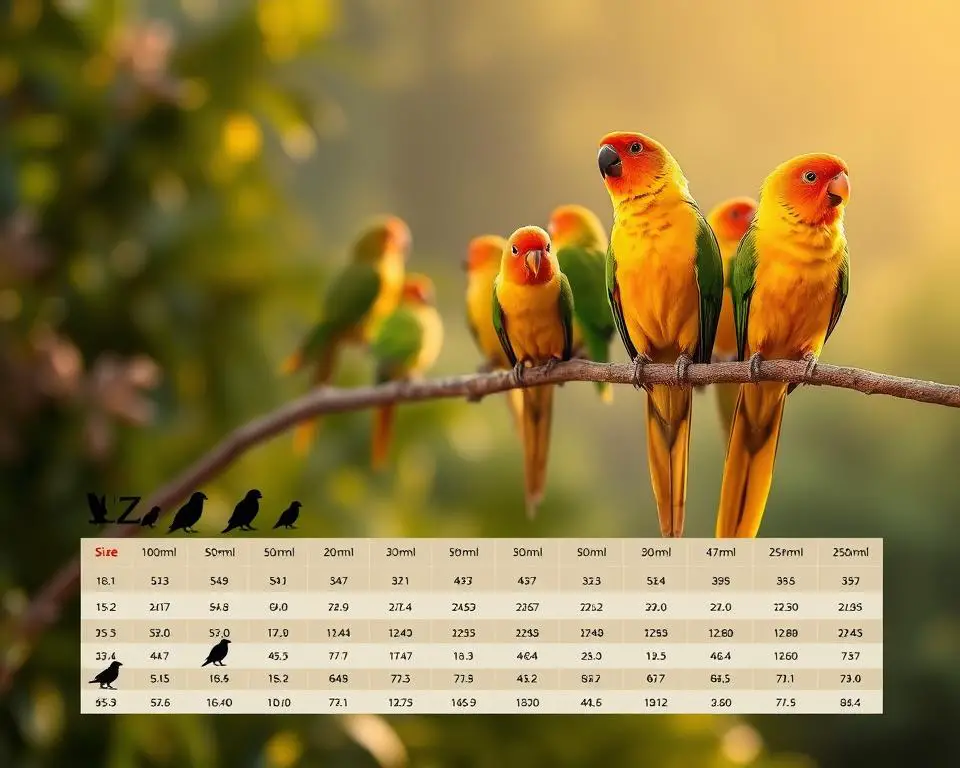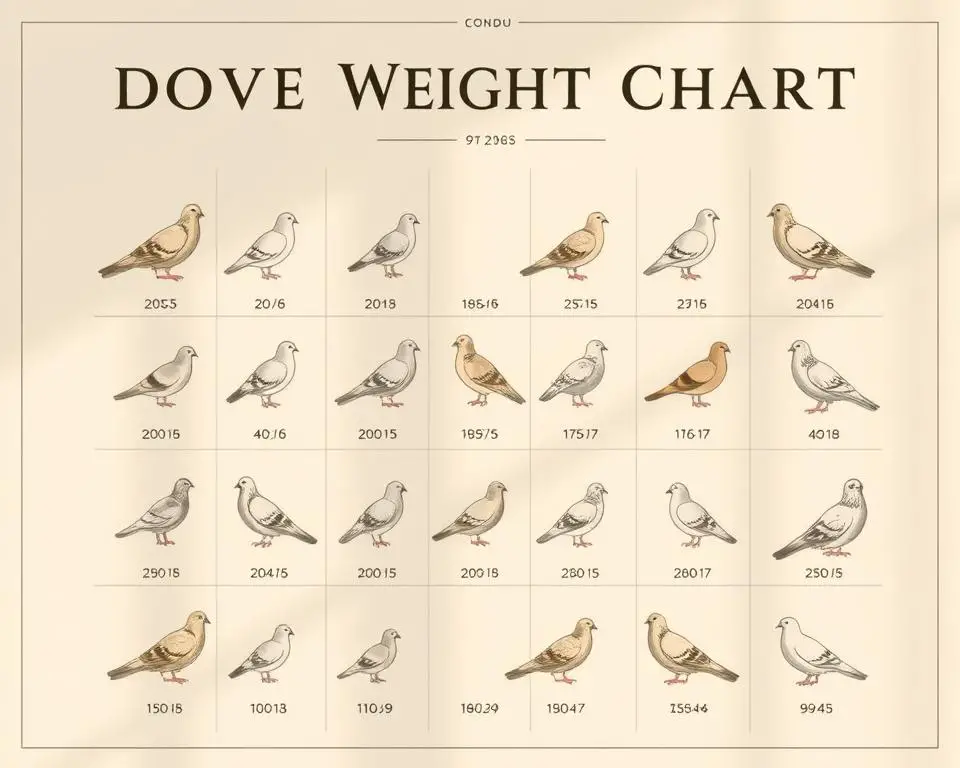Doves are known for their calm nature and beautiful looks. They symbolize peace and purity in many cultures. White doves, in particular, come in a wide range of sizes, from tiny to large.
These birds can be found in small gardens or flying high over big fields. Each size has its own special traits and ways of living. To truly understand white doves, we need to look at their physical and behavioral differences.
Experts and bird fans are fascinated by the variety in dove sizes. Their size affects how they survive, migrate, nest, and live in different places. By studying the different white dove types, we learn more about birds and our world.
This guide is for anyone interested in birds, inviting you to explore from the smallest to the largest doves. As we dive into comparing dove species and exploring white dove varieties, we connect with nature in a deeper way.
Introduction to Dove Sizes and Species
Doves come in all sizes, showing how nature adapts species to different places. This section looks at dove shape, why size matters, and how these traits vary among birds.
Understanding Dove Morphology
Studying dove shape gives us clues about their roles and behaviors. By looking at their wings, tails, and sizes, we see how they fit their homes. These features help them survive and even how they find food and mates.
Size as an Adaptive Trait
Dove size affects how well they handle their environment and find food. Big doves, like the Eurasian Collared-Dove, can keep warm and fly long distances. They also defend their territory. Small doves, like the Common Ground Dove, are quick and can hide in tight spots, making it hard for predators to find them.
| Species | Body Length (cm) | Adaptive Traits |
|---|---|---|
| Eurasian Collared-Dove | 32-34 | Large body size aids in better flight endurance and territorial defense. |
| Common Ground Dove | 15-18 | Small body size facilitates camouflage and agility in dense habitats. |
By comparing doves, we learn more about bird life and how they evolve. This helps us understand their homes and how they interact with them.
The Petite Charmers: Small Dove Varieties
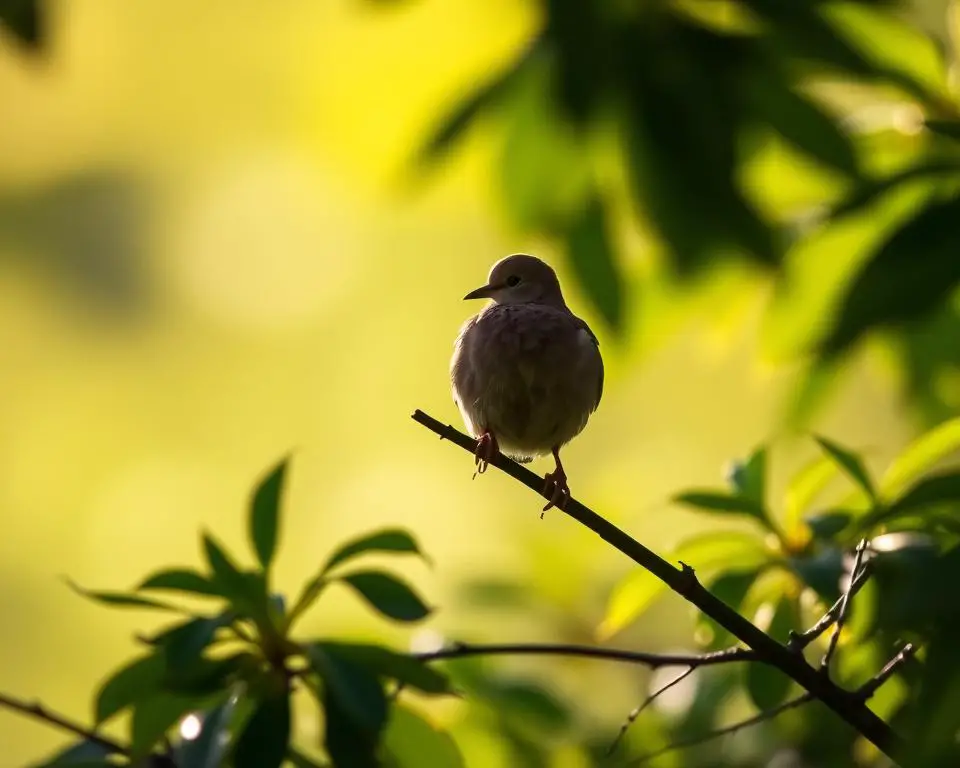
Small dove species are a unique part of birdlife. They are tiny and delicate, showing the wide range of birds worldwide. The Common Ground Dove is especially charming, with its small size and gentle nature.
Common Ground Dove: Nature’s Tiny Gem
The Common Ground Dove stands out among small doves. It has a small body and beautiful colors. Its orange bill makes it even more special.
This bird is great for learning about small doves in nature. To spot a young one, look for white tips on its feathers and white face markings.
The Dainty Features of Juvenile Doves
Identifying young doves can be tricky. They look a lot like adult doves. But, they have white tips on their feathers and white face markings.
These signs are key for telling young doves from adults. They are common in the Common Ground Dove.
Here’s a quick guide to adult and young Common Ground Doves:
| Age Group | Bill Color | Feather Markings | Tail Shape |
|---|---|---|---|
| Adult | Orange | Scaled pattern | Rounded |
| Juvenile | Pale | White tips | Less defined |
Knowing these signs helps bird lovers and scientists. It makes learning about birds more fun and rewarding.
Mourning Doves: The Graceful Mediums
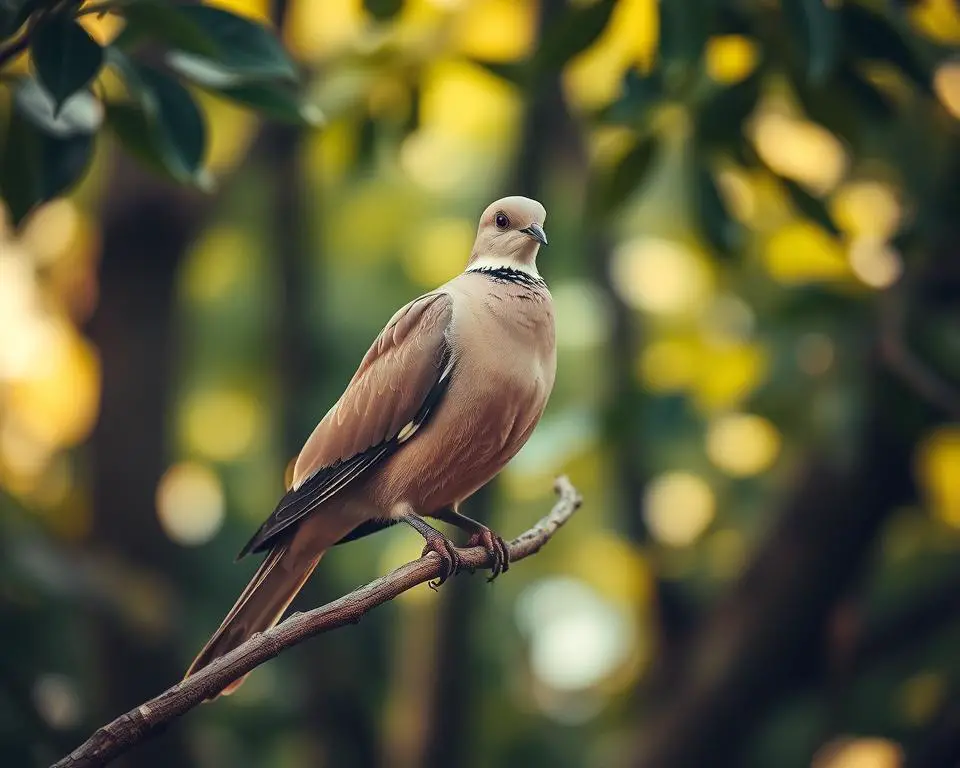
The Mourning Dove characteristics are a mix of gray and peach, making them a hit among birdwatchers. They have slender bills and long tails with white edges. These features add to their grace, making birdwatching more enjoyable.
These doves are often seen in backyards and trees, adding beauty and adaptability. They build simple yet effective nests. Their soft cooing sounds add to their charm.
Watching birdwatching Mourning Dove behavior is fascinating. They feed in small groups, preferring open areas. This lets their sharp eyes find seeds. Sometimes, large flocks gather, creating a lively scene for birdwatchers.
Learning about medium-sized doves helps us appreciate their lives. It also encourages us to protect their habitats. By observing and respecting their behavior, we help their species thrive in our changing world.
White Doves Size Comparison
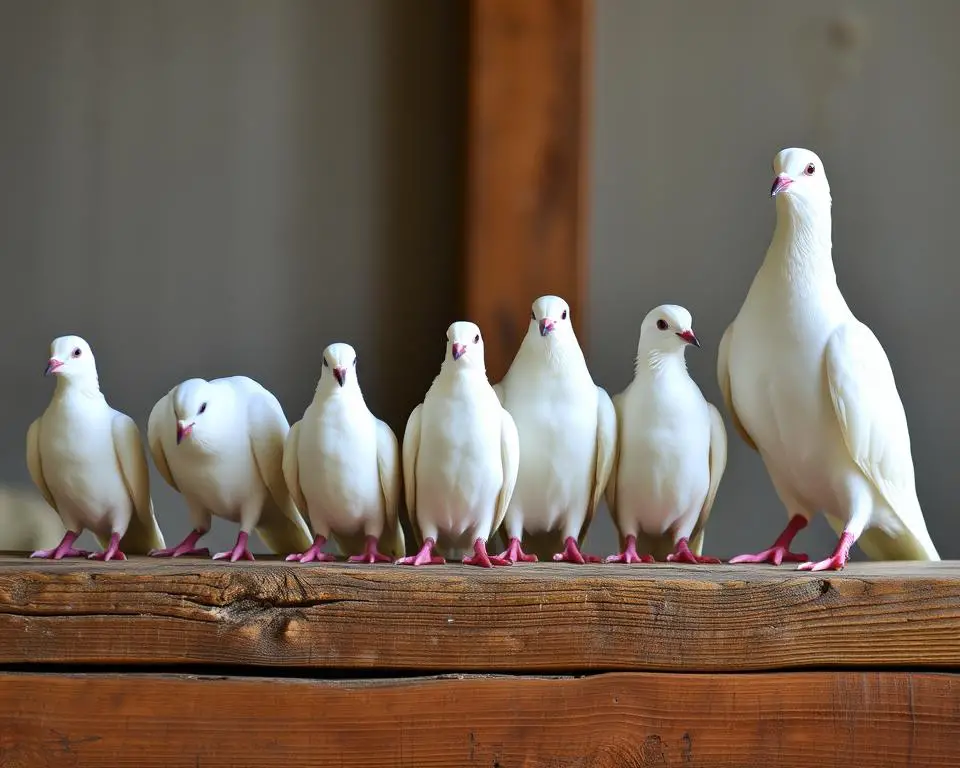
Exploring dove breed sizes and white dove species shows interesting differences. These differences are key for bird lovers and scientists. They help us understand how to tell doves apart and their habits.
Looking at white dove species, we see a range of sizes. From the tiny Common Ground Dove to the bigger Eurasian Collared-Dove, each has its own size. These sizes matter for their survival and how they adapt to their environments.
| Species | Approximate Length | Key Features |
|---|---|---|
| Common Ground Dove | 15-18 cm | Small and compact, with short tails and small bills |
| Mourning Dove | 23-34 cm | Medium-sized, slender, with pointed tails |
| Eurasian Collared-Dove | 32-36 cm | Larger, robust, with a distinct black collar |
By comparing dove sizes, we learn about their habitats. Small doves, like the Common Ground Dove, live in dense areas. They can hide and move easily. Big doves, like the Eurasian Collared-Dove, prefer open spaces. Their size helps them stay safe and seen.
In short, dove breed sizes are different among white dove species. Each size tells us about their lifestyle, behavior, and survival. It’s fascinating for those who love birds and bird watching.
The Robust Eurasian Collared-Dove
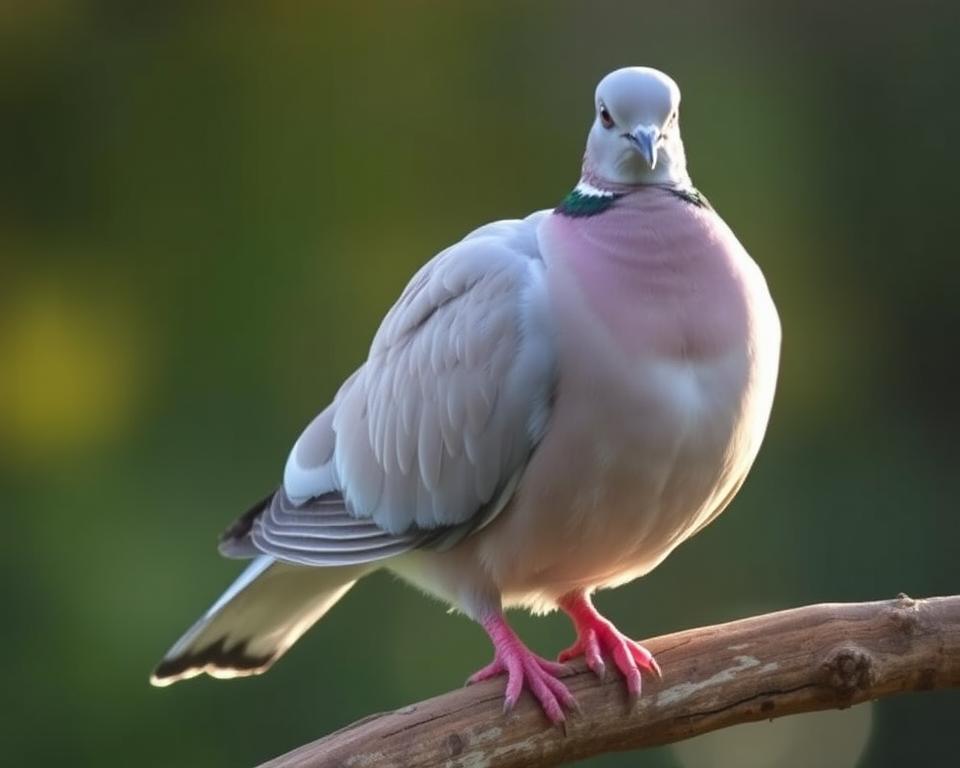
The Eurasian Collared-Dove is a standout among large dove species. It’s known for its size and unique markings. This bird, from Asia, now lives in many parts of the United States. It’s a favorite among bird watchers and scientists who study doves.
This dove has a light brown to gray-buff color that blends well with its surroundings. It’s easy to spot because of its black crescent collar. You can also hear its three-syllable coo, which is clear in quiet places and cities.
This dove species has adapted well to living near humans. It has grown its territory a lot in recent years. Knowing how to identify the Eurasian Collared-Dove is key, whether in nature or cities.
| Feature | Description |
|---|---|
| Size | Larger than most doves, robust body |
| Color | Pale brown to gray-buff, with less contrast than smaller doves |
| Call | Distinct three-syllable coo |
| Collar | Black crescent across the nape |
| Tail | Square-tipped with broad white patches, dark wingtips at the end |
Knowing these features helps identify the Eurasian Collared-Dove. Their presence is a fascinating study on migration and adapting to new places.
Distinct Features of the White-Winged Dove
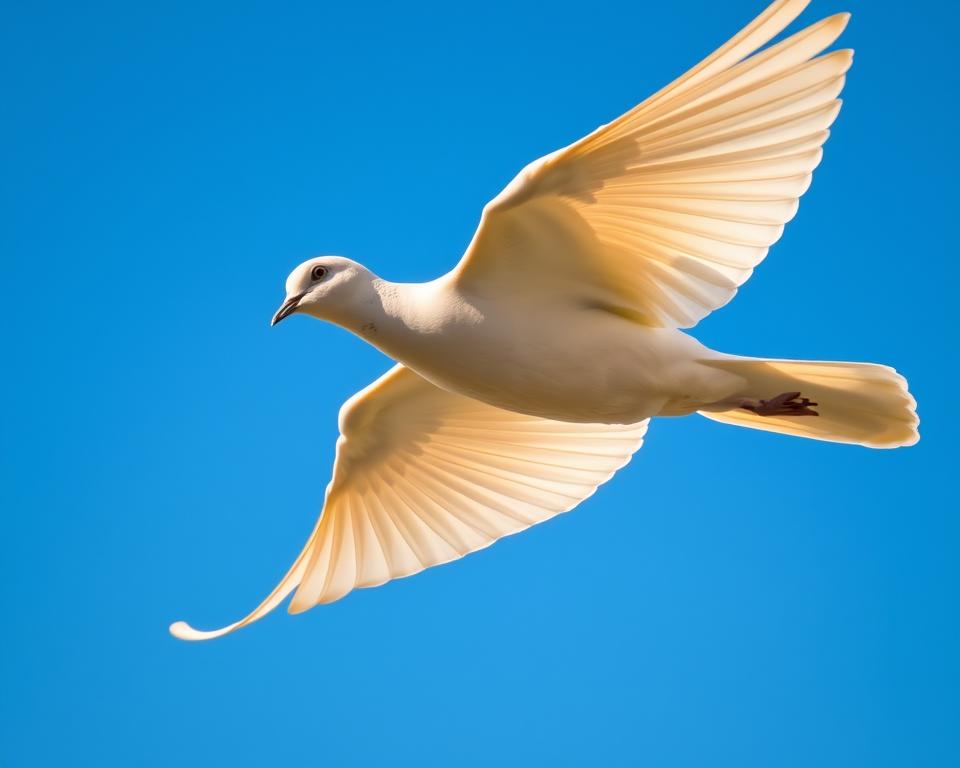
The White-Winged Dove is a fascinating bird that catches the eye of many. It’s a favorite among birdwatchers and scientists. This dove stands out because of its unique looks and behaviors.
White-Winged Dove identification is easy thanks to their striking wing markings. They have clear white patches on their wings, against dark feathers. This makes them easy to spot and shows off the beauty of dove wing patterns.
| Feature | Description |
|---|---|
| Wing Coloration | Dark primary feathers with prominent white patches |
| Tail Shape | Short with white tips, fan-shaped in flight |
| Behavior | Less melodious than Mourning Doves, fast and direct flight |
White-Winged Doves also have unique behaviors. They don’t sing as sweetly as Mourning Doves. Instead, they fly quickly and straight. Their dove behavior helps them survive and connect with their surroundings.
Learning about the White-Winged Dove helps us understand their place in nature. Their wing patterns are not just pretty. They also help with communication and safety in their world.
Understanding Dove Size Through Behavior
Exploring the world of doves reveals a lot about their dove feeding behavior and nesting habits. These behaviors show how size affects their interaction with the environment. Each dove species has its own way of adapting to its surroundings.
Smaller doves have unique feeding strategies compared to larger ones. These strategies are key to their survival and reproduction. The size of a dove’s nest also reflects its size and the needs of its habitat.
| Dove Type | Feeding Behavior | Nesting Habit |
|---|---|---|
| Small Doves (e.g., Common Ground Dove) | Feeds on the ground in small groups, utilizing quick movements to evade predators. | Constructs simple, often ground-level nests using available debris. Compacts in size. |
| Large Doves (e.g., Eurasian Collared-Dove) | Often found in flocks; feeds on a variety of seeds and plants at higher elevations. | Prefers flat, elevated surfaces for robust nest structures, indicative of larger body size. |
The connection between bird size and behavior is fascinating. It shows how doves adapt to their environment. From the tiny Ground Dove to the large Eurasian Collared-Dove, each species fits its life to its size and habitat.
Dove Population and Distribution: Impacts on Size
The way dove population distribution and the environment interact affects dove size. Different habitats pose unique survival challenges and influence growth and size. This section explores how habitat variation and migration patterns impact dove sizes.
Role of Habitat in Size Variation
Habitats play a big role in shaping dove species worldwide. Doves in dense forests grow larger to stay warm and move through foliage. On the other hand, doves in open or dry areas are smaller. This helps them cool down and move quickly. The habitat impact on size is key to understanding dove adaptations.
Migration Patterns and Size Changes
Migrating is tough for doves, needing lots of energy and health. Bigger doves can travel longer distances, helping them survive the journey. Looking at dove migration patterns shows these movements are not just for seasons. They also seek better living conditions, affecting their size over time.
| Habitat Type | Average Size | Common Species |
|---|---|---|
| Forest Areas | Larger | Eurasian Collared-Dove |
| Urban Areas | Medium | Mourning Dove |
| Arid Regions | Smaller | Common Ground Dove |
Hunting and Conservation: The Impact on Dove Sizes
It’s important to understand how dove hunting regulations and bird conservation work together. This balance is key to keeping dove populations healthy and diverse. It affects their sizes and overall health.
Rules are set to manage dove numbers well. They make sure hunting doesn’t harm their growth. These rules consider the species, their homes, and how they breed.
| Species | Regulation Impact | Conservation Status |
|---|---|---|
| Mourning Dove | Limited hunting seasons | Stable, with ongoing monitoring |
| White-Winged Dove | Bag limits and designated areas | Focus on habitat preservation |
Conservation is vital for preserving dove species. It includes protecting their homes, studying them, and teaching people about them. This way, dove sizes and their roles in nature are kept safe.
This careful balance in dove hunting regulations and bird conservation helps us enjoy these birds for years to come. They add value to our ecosystems and outdoor fun.
Conclusion
In our journey through the world of doves, we’ve seen everything from the tiny Common Ground Dove to the large Eurasian Collared-Dove. These birds, with their varied sizes, add to the beauty of our skies. Each dove, big or small, has its own special traits and ways of living.
By studying doves, we learn more about the natural world. We see how these birds adapt to different places, from forests to cities. This shows us how important it is to understand their needs.
Looking at doves, we find ourselves amazed by the diversity of life on Earth. Learning about these birds helps us appreciate nature more. It also helps us work to protect them for the future. Let’s make sure the sound of a dove’s call will always be a joy to hear.


